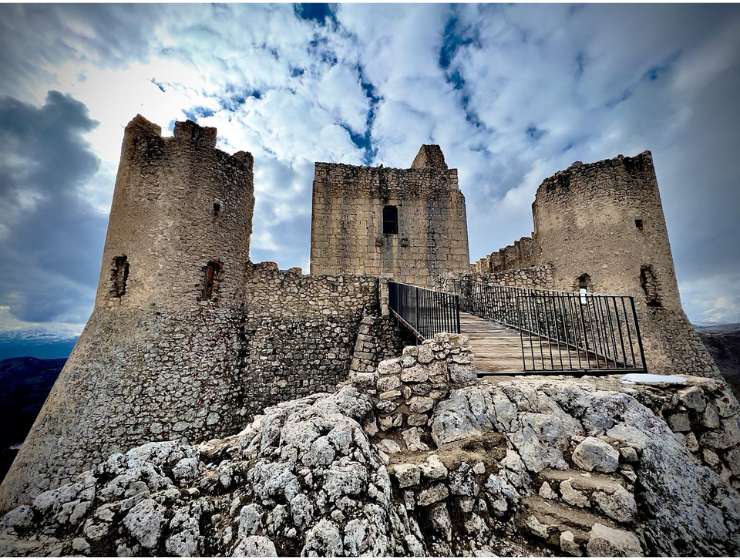A town whose foundation dates back to the early Middle Ages, nestled against the Gran Sasso mountain range and the Campo Imperatore plateau, presents itself as a maze of streets where houses and towers with two or more floors face each other—all rigorously constructed in stone. Squares adorned with patrician houses and churches bear witness to a past of considerable wealth, attributed to the flourishing wool trade.
The signs of devotion from its inhabitants are evident in the marvelous churches of St. Nicholas of Bari, adorned with a wooden portal from the 16th century carved with scenes from the Old Testament and the life of the saint, Santa Maria delle Grazie, rich in works of art, including paintings by Bedeschini and Cavalier d'Arpino, and St. Anthony Abbot from 1645, where you can admire "The Temptations of St. Anthony in the Desert" by Patini today.
But let's return to the medieval charm that envelops Calascio so intensely that it has piqued the interest of Hollywood directors who chose the Rocca as the setting for the famous film Lady Hawke. This fortress, seemingly growing spontaneously from the rock, is a fortified tower with clear functions of surveillance and military communication typical of the late Middle Ages. Near the fortress, you can visit the octagonal chapel dedicated to Madonna della Pietà, dating back to 1451, on a small precipice.
In recent years, some ancient buildings have been renovated and repurposed as holiday homes for summer vacations or weekends.
Rocca Calascio is the highest castle in the Apennines. The tower rises to an altitude of 1460 meters above sea level, dominating the southern slope of the Gran Sasso d'Italia and located on the borders of Campo Imperatore. From the Rocca, the view extends west towards Mount Sirente and Velino, north towards the Gran Sasso and Campo Imperatore, south and part of the east towards the Piana di Navelli. It overlooks the underlying town of Calascio, which is situated at 1200 meters above sea level. In a document from 1380, Rocca Calascio is first mentioned as an isolated watchtower, but the construction of the tower is believed to date back to around the year 1000. Antonio Piccolomini is credited with the construction of the four towers around the original tower of Rocca Calascio, the enclosing wall around the village, and the reconstruction of much of the settlement severely damaged by the earthquakes of 1348/1349 and 1461, around 1480.
Near the Rocca, you will find the Church of Santa Maria della Pietà, built by shepherds towards the end of the 16th century as a thanksgiving to the Madonna following a battle for the defense of the Rocca. The castle, or rather the tower of Rocca Calascio, was an observation point and was able to communicate, perhaps using torches at night and mirrors during daylight through numerous optical connections scattered throughout the territory, with the castles of the Adriatic coast. With the Aragonese domination, the "Customs of sheep driving to Puglia" was established, and transhumant pastoralism became the main source of income for the Kingdom. It was a period of considerable development for the villages of the Baronia, which in 1470 owned over 90,000 sheep and supplied large quantities of prized "carapellese wool" to cities like L'Aquila and Florence.
In 1579, Costanza Piccolomini, the last of the family, sold the Baronia, the Marquisate of Capestrano, and the lands of Ofena and Castel del Monte to Francesco Maria De' Medici, Grand Duke of Tuscany, for 106,000 ducats. In 1743, the territory came under Bourbon rule. In 1703, a disastrous earthquake demolished the castle and the town of Rocca Calascio: only the houses in the lower part of the settlement were rebuilt, and many residents preferred to move to the lower Calascio. A progressive depopulation reduced the number of Rocca's inhabitants from around 800 in 1600 to zero in 1957. Calascio, in turn, began its decline in the late 19th century, suffering the effects of massive emigration in the early decades of the 20th century. A population of about 1,900 in 1860 was reduced to only 299 in 1992.
Today, the Rocca is known to the general public for frequently being the backdrop for major film sets, including "Lady Hawke," a beautiful medieval fable set in the Middle Ages starring Rutger Hauer and Michelle Pfeiffer, "Amici Miei Atto Secondo," "La Piovra," and more.






